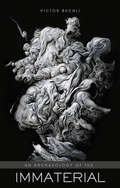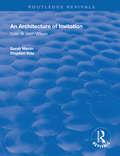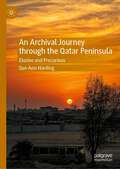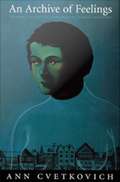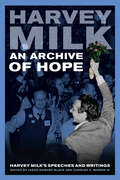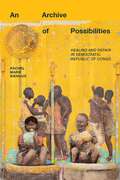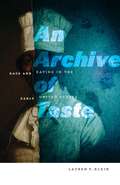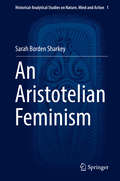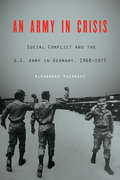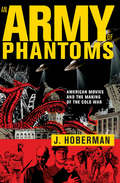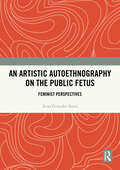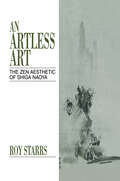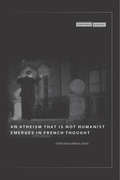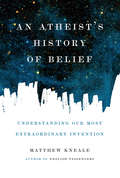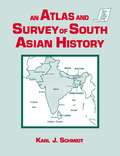- Table View
- List View
An Archaeology of the English Atlantic World, 1600 – 1700
by Charles E. Orser Jr.An Archaeology of the British Atlantic World is the first book to apply the methods of modern-world archaeology to the study of the seventeenth-century English colonial world. Charles E. Orser, Jr explores a range of material evidence of daily life collected from archaeological excavations throughout the Atlantic region, including England, Ireland, western Africa, Native North America, and the eastern United States. He considers the archaeological record together with primary texts by contemporary writers. Giving particular attention to housing, fortifications, delftware, and stoneware, Orser offers new interpretations for each type of artefact. His study demonstrates how the archaeological record expands our understanding of the Atlantic world at a critical moment of its expansion, as well as to the development of the modern, Western world.
An Archaeology of the Immaterial
by Victor BuchliAn Archaeology of the Immaterial examines a highly significant but poorly understood aspect of material culture studies: the active rejection of the material world. Buchli argues that this is evident in a number of cultural projects, including anti-consumerism and asceticism, as well as other attempts to transcend material circumstances. Exploring the cultural work which can be achieved when the material is rejected, and the social effects of these ‘dematerialisations’, this book situates the way some people disengage from the world as a specific kind of physical engagement which has profound implications for our understanding of personhood and materiality. Using case studies which range widely in time over Western societies and the technologies of materialising the immaterial, from icons to the scanning tunnelling microscope and 3-D printing, Buchli addresses the significance of immateriality for our own economics, cultural perceptions, and emerging forms of social inclusion and exclusion. An Archaeology of the Immaterial is thus an important and innovative contribution to material cultural studies which demonstrates that the making of the immaterial is, like the making of the material, a profoundly powerful operation which works to exert social control and delineate the borders of the imaginable and the enfranchised.
An Archaeology of the Margins: Colonialism, Amazighity and Heritage Management in the Canary Islands (SpringerBriefs in Archaeology)
by A. José Farrujia de la RosaThis book analyses the problematics of archaeological heritage management in the Canary Islands, which are echoed in other parts of the world where the indigenous heritage is under-represented. The present-day management of Canarian archaeological heritage has a very specific and unusual context given that the archipelago is located on the fringes of Europe, belonging to Spain and therefore to the European Unión, but geographically and in terms of early history being part of Africa. From a theoretical perspective, then, the proposed book analyzes issues such as the effects of colonialism and eurocentrism on the management of the archaeological heritage. It also examines the evolutionist and historico-cultural models used to analyze past societies and, ultimately, used to create identities that influence archaeological heritage management itself. From a practical point of view, the book presents a proposal for enhancing the archaeological heritage of the Canary Islands through the creation of archaeological parks (providing some concrete examples in the case of the city of La Laguna) and the active involvement of the local community. Parallel to this, the book considers the Canarian Archipelago as part of a problematic that is not unique to this area but is an example of poor indigenous heritage management overall. It demonstrates how the course of history and the politics of the past still have an excessive influence on the way in which the present-day archaeological heritage is interpreted and managed. Therefore, this book provides an almost unique opportunity for uncovering the history of archaeology within the margins of Europe (in fact, in an African region) and exploring colonial and foreign influences. In many ways it is a mirror of archaeological mainstreams and an exercise in (re)thinking the aim and status of present-day archaeology.
An Archaeology of the Soul: North American Indian Belief and Ritual
by Robert L. HallThis book describes North American Indian beliefs and rituals. It also includes bibliographical references and an index.
An Archipelago of Care: Filipino Migrants and Global Networks (Framing the Global)
by Deirdre McKayA study of Filipino caregivers in London and what it says for migrant workers and the networks they build in the global marketplace.Focusing on the experience of Filipino caregivers in London, some of whom are living and working illegally in their host country, Deirdre McKay considers what migrant workers must do to navigate their way in a global marketplace. She draws on interviews and participant observations, her own long-term fieldwork in communities in the Philippines, and digital ethnography to present an intricate consideration of how these caregivers create stability in potentially precarious living situations. McKay argues that these workers gain resilience from the bonding networks they construct for themselves through social media, faith groups, and community centers. These networks generate an elaborate “archipelago of care” through which migrants create their sense of self.“A beautifully written ethnography of Filipino migrants in the UK and their experience of living their lives within and across the UK and the Philippines, mediated by physical space, institutions and a series of digital media.” —Heather Horst, coauthor of Digital Ethnography: Principles and Practices“Deirdre McKay takes a novel approach to key concepts undergirding globalization and transnationalism today—citizenship, surveillance, and security. She makes us think differently about the negotiation of belonging in a digital and hyper-securitized age.” —Jennifer Burrell, author of Maya After War: Conflict, Power, and Politics in Guatemala
An Architecture of Invitation: Colin St John Wilson (Routledge Revivals)
by Stephen Kite Sarah MeninFirst published in 2005, An Architecture of invitation: Colin St John Wilson is a distinctive study of the life and architectural career of one of the most significant makers, theorists and teachers of architecture to have emerged in England in the second half of the twentieth century. Exceptionally in an architectural study, this book interweaves biography, critical analysis of the projects, and theory, in its aims of explicating the richness of Wilson’s body of work, thought and teaching. Drawing on the specialisms of its authors, it also examines the creative and psychological impulses that have informed the making of the work – an oeuvre whose experiential depth is recognised by both users and critics.
An Archival Journey through the Qatar Peninsula: Elusive and Precarious
by Sue-Ann HardingThis book retrieves from the archives people, places and perspectives normally overlooked to tell an original and expansive history of the Qatar Peninsula, paying close attention to landscape and the natural world. The arc of the book moves geographically through the landscape and chronologically through selected sources, drawing on digitised maps, manuscripts, hydrographic surveys, government records, traveller accounts, early photographs, archaeological and ethnographic reports. While these are standard sources recruited by Qatar to tell its own singular, streamlined history, this book is a subversive reading of those sources. It braids together elusive and precarious stories – difficult to find, at risk of being lost, and never before brought together into a single volume – to write a more complicated story of place. Through them, we can reimagine a place that, like many in the world, works hard to control a limited set of stories about itself. Readers who know something about Qatar will be surprised by the book’s nuances and details. Readers who know little or nothing will be drawn in to discover that, even in the most out-of-the-way and inhospitable places, deserts are never empty.
An Archive of Feelings: Trauma, Sexuality, and Lesbian Public Cultures
by Ann CvetkovichIn this bold new work of cultural criticism, Ann Cvetkovich develops a queer approach to trauma. She argues for the importance of recognizing--and archiving--accounts of trauma that belong as much to the ordinary and everyday as to the domain of catastrophe. An Archive of Feelings contends that the field of trauma studies, limited by too strict a division between the public and the private, has overlooked the experiences of women and queers. Rejecting the pathologizing understandings of trauma that permeate medical and clinical discourses on the subject, Cvetkovich develops instead a sex-positive approach missing even from most feminist work on trauma. She challenges the field to engage more fully with sexual trauma and the wide range of feelings in its vicinity, including those associated with butch-femme sex and aids activism and caretaking. An Archive of Feelings brings together oral histories from lesbian activists involved in act up/New York; readings of literature by Dorothy Allison, Leslie Feinberg, Cherre Moraga, and Shani Mootoo; videos by Jean Carlomusto and Pratibha Parmar; and performances by Lisa Kron, Carmelita Tropicana, and the bands Le Tigre and Tribe 8. Cvetkovich reveals how activism, performance, and literature give rise to public cultures that work through trauma and transform the conditions producing it. By looking closely at connections between sexuality, trauma, and the creation of lesbian public cultures, Cvetkovich makes those experiences that have been pushed to the peripheries of trauma culture the defining principles of a new construction of sexual trauma--one in which trauma catalyzes the creation of cultural archives and political communities.
An Archive of Hope: Harvey Milk's Speeches and Writings
by Frank M. Robinson Charles E. Morris III Jason Edward Black Harvey MilkHarvey Milk was one of the first openly and politically gay public officials in the United States, and his remarkable activism put him at the very heart of a pivotal civil rights movement reshaping America in the 1970s. An Archive of Hope is Milk in his own words, bringing together in one volume a substantial collection of his speeches, columns, editorials, political campaign materials, open letters, and press releases, culled from public archives, newspapers, and personal collections. The volume opens with a foreword from Milk's friend, political advisor, and speech writer Frank Robinson, who remembers the man who "started as a Goldwater Republican and ended his life as the last of the store front politicians" who aimed to "give 'em hope" in his speeches. An illuminating introduction traces GLBTQ politics in San Francisco, situates Milk within that context, and elaborates the significance of his discourse and memories both to 1970s-era gay rights efforts and contemporary GLBTQ worldmaking.
An Archive of Possibilities: Healing and Repair in Democratic Republic of Congo (Critical Global Health: Evidence, Efficacy, Ethnography)
by Rachel Marie NiehuusIn An Archive of Possibilities, anthropologist and surgeon Rachel Marie Niehuus explores possibilities of healing and repair in the eastern Democratic Republic of Congo against a backdrop of 250 years of Black displacement, enslavement, death, and chronic war. Niehuus argues that in a context in which violence characterizes everyday life, Congolese have developed innovative and imaginative ways to live amid and mend from repetitive harm. Drawing on ethnographic fieldwork and the Black critical theory of Achille Mbembe, Christina Sharpe, Alexis Pauline Gumbs and others, Niehuus explores the renegotiation of relationships with land as a form of public healing, the affective experience of living in insecurity, the hospital as a site for the socialization of pain, the possibility of necropolitical healing, and the uses of prophesy to create collective futures. By considering the radical nature of cohabitating with violence, Niehuus demonstrates that Congolese practices of healing imagine and articulate alternative ways of living in a global regime of antiblackness.
An Archive of Taste: Race and Eating in the Early United States
by Lauren F. KleinA groundbreaking synthesis of food studies, archival theory, and early American literature There is no eating in the archive. This is not only a practical admonition to any would-be researcher but also a methodological challenge, in that there is no eating—or, at least, no food—preserved among the printed records of the early United States. Synthesizing a range of textual artifacts with accounts (both real and imagined) of foods harvested, dishes prepared, and meals consumed, An Archive of Taste reveals how a focus on eating allows us to rethink the nature and significance of aesthetics in early America, as well as of its archive.Lauren F. Klein considers eating and early American aesthetics together, reframing the philosophical work of food and its meaning for the people who prepare, serve, and consume it. She tells the story of how eating emerged as an aesthetic activity over the course of the eighteenth century and how it subsequently transformed into a means of expressing both allegiance and resistance to the dominant Enlightenment worldview. Klein offers richly layered accounts of the enslaved men and women who cooked the meals of the nation&’s founders and, in doing so, directly affected the development of our national culture—from Thomas Jefferson&’s emancipation agreement with his enslaved chef to Malinda Russell&’s Domestic Cookbook, the first African American–authored culinary text.The first book to examine the gustatory origins of aesthetic taste in early American literature, An Archive of Taste shows how thinking about eating can help to tell new stories about the range of people who worked to establish a cultural foundation for the United States.
An Aristotelian Feminism (Historical-Analytical Studies on Nature, Mind and Action #1)
by Sarah Borden SharkeyThis book articulates the theoretical outlines of a feminism developed from Aristotle's metaphysics, making a new contribution to feminist theory. Readers will discover why Aristotle was not a feminist and how he might have become one, through an investigation of Aristotle and Aristotelian tradition. The author shows how Aristotle's metaphysics can be used to articulate a particularly subtle and theoretically powerful understanding of gender that may offer a highly useful tool for distinctively feminist arguments. This work builds on Martha Nussbaum's 'capabilities approach' in a more explicitly and thoroughly hylomorphist way. The author shows how Aristotle's hylomorphic model, developed to run between the extremes of Platonic dualism and Democritean atomism, can similarly be used today to articulate a view of gender that takes bodily differences seriously without reducing gender to biological determinations. Although written for theorists, this scholarly yet accessible book can be used to address more practical issues and the final chapter explores women in universities as one example. This book will appeal to both feminists with limited familiarity with Aristotle's philosophy, and scholars of Aristotle with limited familiarity with feminism.
An Army in Crisis: Social Conflict and the U.S. Army in Germany, 1968–1975
by Alexander VazanskyFollowing the decision to maintain 250,000 U.S. troops in Germany after the Allied victory in 1945, the U.S. Army had, for the most part, been a model of what a peacetime occupying army stationed in an ally’s country should be. The army had initially benefited from the positive results of U.S. foreign policy toward West Germany and the deference of the Federal Republic toward it, establishing cordial and even friendly relations with German society. By 1968, however, the disciplined military of the Allies had been replaced with rundown barracks and shabby-looking GIs, and U.S. bases in Germany had become a symbol of the army’s greatest crisis, a crisis that threatened the army’s very existence. In An Army in Crisis Alexander Vazansky analyzes the social crisis that developed among the U.S. Army forces stationed in Germany between 1968 and 1975. This crisis was the result of shifting deployment patterns across the world during the Vietnam War; changing social and political realities of life in postwar Germany and Europe; and racial tensions, drug use, dissent, and insubordination within the U.S. Army itself, influenced by the civil rights movement, the Vietnam War, and the youth movement in the States. With particular attention to 1968, An Army in Crisis examines the changing relationships between American and German soldiers, from German deference to familiarity and fraternization, and the effects that a prolonged military presence in Germany had on American military personnel, their dependents, and the lives of Germans. Vazansky presents an innovative study of opposition and resistance within the ranks, affected by the Vietnam War and the limitations of personal freedom among the military during this era.
An Army of Phantoms: American Movies and the Making of the Cold War
by J. HobermanThe film critic&’s sweeping analysis of American cinema in the Cold War era is both &“utterly compulsive reading [and] majestic&” in its &“breadth and rigor&” (Film Comment). An Army of Phantoms is a major work of film history and cultural criticism by leading film critic J. Hoberman. Tracing the dynamic interplay between politics and popular culture, Hoberman offers &“the most detailed year-by-year look at Hollywood during the first decade of the Cold War ever published, one that takes film analysis beyond the screen and sets it in its larger political context&” (Los Angeles Review of Books). By &“tell[ing] the story not just of what&’s on the screen but of what played out behind it,&” Hoberman demonstrates how the nation&’s deep-seated fears and wishes were projected onto the big screen. In this far-reaching work of historical synthesis, Cecil B. DeMille rubs shoulders with Douglas MacArthur, atomic tests are shown on live TV, God talks on the radio, and Joe McCarthy is bracketed with Marilyn Monroe (The American Scholar). From cavalry Westerns to apocalyptic sci-fi flicks, and biblical spectaculars; from movies to media events, congressional hearings and political campaigns, An Army of Phantoms &“remind[s] you what criticism is supposed to be: revelatory, reflective and as rapturous as the artwork itself&” (Time Out New York). &“An epic . . . alternately fevered and measured account of what might be called the primal scene of American cinema.&” —Cineaste &“There&’s something majestic about the reach of Hoberman&’s ambitions, the breadth and rigor of his research, and especially the curatorial vision brought to historical data.&” —Film Comment
An Artist's Journey to Bali
by Betty ReynoldsWritten and illustrated by renowned artist Betty Reynolds, An Artist's Journey to Bali is a cultural exploration into the mysterious Indonesian island of Bali. In this beautifully illustrated artist's sketchbook, the author shares her good fortune of meeting many Balinese who allowed her to witness important aspects of their lives and culture, and to participate in the religious rituals that mark their passage through the major stages of life.
An Artist's Journey to Bali
by Betty ReynoldsWritten and illustrated by renowned artist Betty Reynolds, An Artist's Journey to Bali is a cultural exploration into the mysterious Indonesian island of Bali. In this beautifully illustrated artist's sketchbook, the author shares her good fortune of meeting many Balinese who allowed her to witness important aspects of their lives and culture, and to participate in the religious rituals that mark their passage through the major stages of life.
An Artist's Journey to Bali
by Betty ReynoldsAn Artist's Journey to Bali is much more than your usual tourist guide to the beautiful and mysterious Indonesian island of Bali. Written and illustrated by renowned artist Betty Reynolds, this book contains the author's Balinese watercolor art depicting the wonderful island whose inhabitants are known to adhere to daily rituals that, although unfamiliar to foreigners, give the island and its people a distinct aura of mystery and magic.In this beautifully illustrated artist's sketchbook, the author shares her good fortune of meeting many Balinese who allowed her to witness important aspects of their lives and culture, and to participate in the religious rituals that mark their passage through the major stages of life.If Bali travel is in your future, this is a great book to have. It takes you right into the Balinese culture, exploring the art of Bali, unveiling the traditions and spirituality in that part of the world. Take a rare journey to a beautiful place, as Betty invites you to experience it with an artist Journey to Bali.
An Artistic Autoethnography on the Public Fetus: Feminist Perspectives
by Anna Gonzalez SueroAn Artistic Autoethnography on the Public Fetus explores artistic work with the iconic image of the fetus and the personal consequences of the image by analyzing the so-called public fetus within a feminist approach.This book develops a deeply interdisciplinary body of research, engaging with feminist debates on reproductive technology and imagery, art theory, visual histories of anatomical imagery, cultural critiques of the myth of the artistic genius, Gestalt understandings of perception and memory, and anthropological theories of liminality. Through blurring the artistic with the scientific, it explores the potential of autoethnography to serve as a form of conscious raising through which to create new images and stories that counter the public fetus in support of reproductive autonomy and social justice.This book will be useful to feminist scholars who work with issues related to gender, reproduction, sexuality, and autoethnography. At the same time, the book will be of value to undergraduate and graduate students in gender studies as an example of how an autoethnographic process can make unrecognized experiences of gender known to a person.
An Artless Art - The Zen Aesthetic of Shiga Naoya: A Critical Study with Selected Translations
by Roy StarrsShiga Naoya was a giant of Japanese literature but he is barely known outside Japan. This book is the first study of Shiga to explore in depth his affinities - both aesthetic and philosophic - with the long tradition of Zen art.
An Arts-Based Inquiry of Sibling Disability: Stealing from My Sister’s Plate (Interdisciplinary Disability Studies)
by Linnéa E. FranitsThis book examines texts and other artistic products rendered by siblings of individuals with disabilities in order to interrogate the impact of disability on the identity of non-disabled siblings. This includes an arts-based analysis of the author’s own experiences as the sister of a woman with disabilities as depicted in photo essays and autoethnographic texts. By providing an alternate presentation of the topics surrounding sibling disability it gives readers a deeper and broader perspective of the lived experience of sibling disability by introducing them to some of the knowledge that is specifically, and perhaps singularly available to siblings of people with disabilities. Presenting findings from narrative analysis, visual analysis, autoethnographic and arts-based research related to sibling disability, it challenges the grand narratives that persist in many cultural products and medical discourses around sibling disability.It will be of interest to all scholars and students of disability studies, sociology, childhood studies, family studies and the arts more broadly.
An Asian American Theology of Liberation
by Tian An WongWhat does liberation mean for Asians at the core of an anti-Black, settler-colonial empire? This landmark book is the first to offer an Asian American theology of liberation for the present and future global crises. The broad scope of contemporary ideas that the book engages with will be of interest to students, activists, clergy, and scholars alike. Readers interested in radical politics, political theology, and Asian American history will find this book an important addition to their bookshelves. Providing an intersectional frame that considers the breadth and diversity of Asian American experiences alongside those of Black, Indigenous, and Latinx thinkers in the United States and across the globe, An Asian American Theology of Liberation puts Asian American theology in dialogue with theories from psychoanalysis, Afro-pessimism, Black Marxism, postcolonial studies, and queer theology. In this groundbreaking work, Wong Tian An combines archival research uncovering a much overlooked theology of liberation — born in the 1970s out of Asian Americans’ struggles for political recognition and civil rights in the United States — with powerful analyses drawing from the theological, intellectual, and political developments of the last half century. This wide-ranging study connects urgent themes such as protest movements in Hong Kong, anti-Asian violence in the United States, and Indigenous struggles everywhere, while building on Asian theologies such as Dalit theology in India, theology of struggle in the Philippines, and Minjung theology in Korea. Drawing deeply and broadly across disciplines, the book altogether revives and renews an Asian American theology of liberation for a new generation.
An Asian Frontier: American Anthropology and Korea, 1882–1945 (Critical Studies in the History of Anthropology)
by Robert OppenheimIn the nineteenth century the predominant focus of American anthropology centered on the native peoples of North America, and most anthropologists would argue that Korea during this period was hardly a cultural area of great anthropological interest. However, this perspective underestimates Korea as a significant object of concern for American anthropology during the period from 1882 to 1945—otherwise a turbulent, transitional period in Korea’s history. An Asian Frontier focuses on the dialogue between the American anthropological tradition and Korea, from Korea’s first treaty with the United States to the end of World War II, with the goal of rereading anthropology’s history and theoretical development through its Pacific frontier. Drawing on notebooks and personal correspondence as well as the publications of anthropologists of the day, Robert Oppenheim shows how and why Korea became an important object of study—with, for instance, more published about Korea in the pages of American Anthropologist before 1900 than would be seen for decades after. Oppenheim chronicles the actions of American collectors, Korean mediators, and metropolitan curators who first created Korean anthropological exhibitions for the public. He moves on to examine anthropologists—such as Aleš Hrdlicka, Walter Hough, Stewart Culin, Frederick Starr, and Frank Hamilton Cushing—who fit Korea into frameworks of evolution, culture, and race even as they engaged questions of imperialism that were raised by Japan’s colonization of the country. In tracing the development of American anthropology’s understanding of Korea, Oppenheim discloses the legacy present in our ongoing understanding of Korea and of anthropology’s past.
An Atheism That Is Not Humanist Emerges in French Thought
by Stefanos GeroulanosIf the 19th century was marked by a "Death of God," than the 20th century evolution of French philosophical and political thought can be said to be marked by the "Death of Man," in that humanism (placing the human at the center of understandings of knowledge, thought, and ethics) came to be seen by many as inextricably tied to some of the worst disasters of the modern era. Geroulanos (modern European intellectual history, New York U. ) reconstructs the development of this intellectual trend in France during the second quarter of the 20th century, arguing that it should be understood in terms of a synthesis of the interconnected movements of the development of an anti-humanist atheism, the emergence of a negative philosophical anthropology, and the elaboration of critiques of humanism. Annotation ©2010 Book News, Inc. , Portland, OR (booknews. com)
An Atheist's History of Belief: Understanding Our Most Extraordinary Invention
by Matthew KnealeWhat first prompted prehistoric man, sheltering in the shadows of deep caves, to call upon the realm of the spirits? And why has belief thrived since, shaping thousands of generations of shamans, pharaohs, Aztec priests and Mayan rulers, Jews, Buddhists, Christians, Nazis, and Scientologists?As our dreams and nightmares have changed over the millennia, so have our beliefs. The gods we created have evolved and mutated with us through a narrative fraught with human sacrifice, political upheaval and bloody wars.Belief was man's most epic labor of invention. It has been our closest companion, and has followed mankind across the continents and through history.
An Atlas and Survey of South Asian History (Sources And Studies In World History Ser.)
by Karl J. SchmidtThis historical atlas is devoted primarily to India, Bangladesh and Pakistan, while also covering Napal, Bhutan and Ceylon/Sri Lanka. The maps are accompanied by text which illuminates recent political, economic, social and cultural developments.

